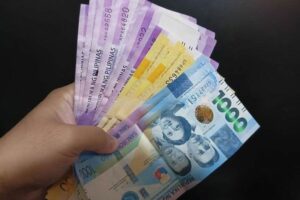THE PESO surged to a near six-month high on Thursday as the dollar weakened due to global growth concerns after the Trump administration announced sweeping tariffs on imports.
The local unit closed at P57.095 per dollar on Thursday, rising by 12 centavos from its P57.215 finish on Wednesday, Bankers Association of the Philippines data showed.
This was the peso’s strongest finish in nearly six months or since it ended at P57.02 per dollar on Oct. 9, 2024.
The peso opened Thursday’s session slightly weaker at P57.25 against the dollar. Its worst showing was at P57.275, while its intraday best was at P57.06 versus the greenback.
Dollars exchanged rose to $1.26 billion on Thursday from $1.07 billion on Wednesday.
The dollar was generally weaker on Thursday as markets feared that the tariffs set to be implemented by the US could hamper global growth, Rizal Commercial Banking Corp. Chief Economist Michael L. Ricafort said in a Viber message.
“The peso appreciated significantly as the dollar suffered from growing concerns over the negative impact to the US economy from the broad-based tariffs announced by President Donald J. Trump today,” a trader said in an e-mail.
The dollar slid broadly on Thursday and the euro firmed after Mr. Trump announced harsher-than-expected tariffs against US trading partners, jolting the markets as investors sought safe havens such as the yen and Swiss franc, Reuters reported.
The highly anticipated tariff announcement sent shockwaves through markets, with global stocks sinking and investors scrambling to the safety of bonds as well as gold.
Mr. Trump said he would impose a 10% baseline tariff on all imports to the United States and higher duties on some of the country’s biggest trading partners. The tariffs will take effect on April 9 and appeared to target about 60 countries.
The new levies ratchet up a trade war that Mr. Trump kicked off on his return to the White House, rattling markets as fears grow that a full-blown trade war could trigger a sharp global economic slowdown and fuel inflation.
Mr. Trump has already imposed tariffs on aluminum, steel and autos, and has increased duties on all goods from China.
“Eye-watering tariffs on a country-by-country basis scream ‘negotiation tactic,’ which will keep markets on edge for the foreseeable future,” said Adam Hetts, global head of multi-asset and portfolio manager at Janus Henderson Investors.
“We’ve seen the administration have a surprisingly high tolerance for market pain, now the big question is how much tolerance it has for true economic pain as negotiations unfold.”
The risk-sensitive Australian dollar fell 0.49% to $0.62685, while the New Zealand dollar slipped 0.2% to $0.5733.
The yen strengthened to a three-week high against the dollar and was last up 1.3% at 147.39 per dollar, while the Swiss franc touched its strongest level in four months at 0.8754 per dollar.
Benchmark 10-year Treasury yields tumbled 15 basis points to a five-month low of 4.04% as investors braced for slower US growth, while interest rate futures priced in a higher chance of interest rate cuts in the months ahead.
Investors are worried that some US trading partners could retaliate with measures of their own, leading to higher prices.
Worries about a global trade war have intensified since Mr. Trump stepped into the White House in January, combining with a slew of weaker-than-expected US data to stoke recession fears and undermine the dollar.
The dollar index, which measures the US currency against six other units, fell to 102.98, its lowest since mid-October. The index is down more than 4% this year.
The euro rose nearly 1% to a two-week high of $1.0950, while sterling rose 0.66% to $1.3097, its strongest level in five months.
For Friday, the trader said the peso could rise further on expectations of slower Philippine headline inflation data in March.
The Philippine Statistics Authority will release March consumer price index (CPI) data on April 4 (Friday).
Headline inflation likely settled within 1.7% to 2.5% last month, the Bangko Sentral ng Pilipinas (BSP) said on Monday. If realized, this would be slower than the 3.7% inflation print in March 2024.
At the upper end of the BSP forecast, inflation likely accelerated from 2.1% in February.
The low end showed inflation may have slowed below 2% for the first time since the 1.9% print in September 2024. It could also mark the slowest inflation since 1.6% in May 2020.
A BusinessWorld poll of 18 analysts conducted last week yielded a median estimate of 2% for the March CPI.
The trader expects the peso to move between P56.95 and P57.20 per dollar on Friday, while Mr. Ricafort sees it ranging from P57 to P57.20. — A.M.C. Sy with Reuters

